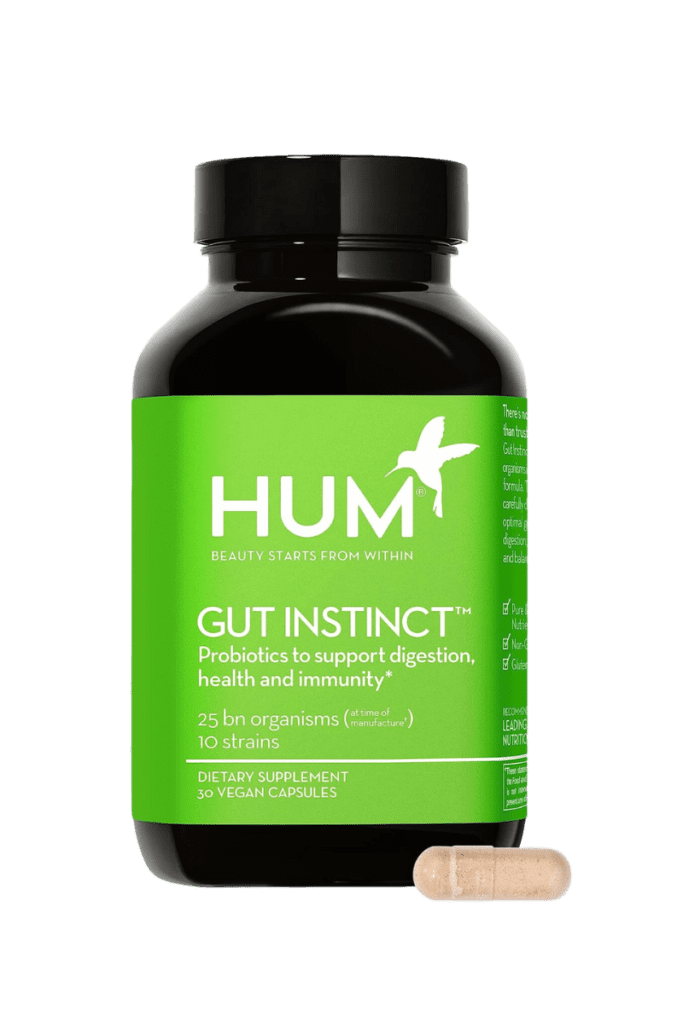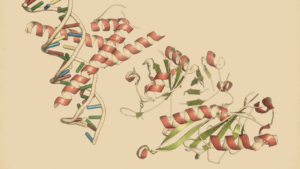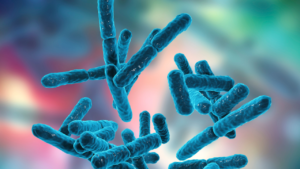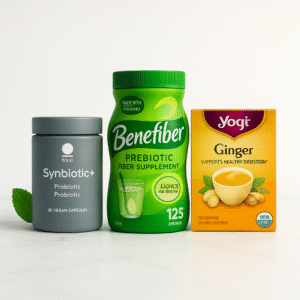The 8 Amazing Health Benefits Of Prebiotic Fiber
Discover the incredible health benefits of prebiotic fiber and how it can improve your gut health. Dive into the science behind for a healthier lifestyle.

Prebiotic fiber serves as a source of carbon for both primary and secondary fermentation pathways in the colon, which can contribute to maintaining digestive health in various ways.
Fructooligosaccharides, inulin, and galactooligosaccharides are widely recognized as prebiotics.
The health benefits of these compounds are widely recognized to be attributed to their ability to be fermented by gut microbiota.
Keywords: prebiotic fibers, prebiotic, digestive health, gut microbiota, gut microbiome.
Introduction
Prebiotics were initially defined in 1995 and their definition has since undergone further development✅.
The health effects of prebiotic fibers have not been extensively studied✅✅.
Prebiotic fibers are compounds that shape the microbiota by serving as a carbon source for the growth of beneficial bacteria. This selective change contributes to the host's health by positively impacting its metabolism.
Research on prebiotic fiber has shown that changes in some gut bacteria are often associated with good health, but this does not necessarily provide a direct health benefit in most cases✅.
The health benefits have been shown to provide positive effects on the body's metabolism of prebiotic fibers.
As the consumption of prebiotics increases and the demand for foods containing these ingredients rises, it is important to have a clear understanding of the appropriate usage of the term "prebiotic".
In this paper, we aim to provide a clear definition of prebiotic dietary fiber and highlight the specific fibers that have been scientifically proven to be prebiotics.
We hope to establish a better understanding of the relationship between dietary fiber and prebiotics.
HIGHLIGHT
Prebiotic fibers help beneficial gut bacteria grow and can be good for metabolism, but we don't know much about their health benefits yet.
What is Prebiotic?
The term "prebiotic" was first defined in 1995 as a type of non-digestible food ingredient that has a positive effect on the host by selectively stimulating the growth and/or activity of a limited number of bacteria in the colon, thus improving host health✅.
Over the years, this definition has evolved to include a selectively fermented ingredient that allows specific changes in the composition and/or activity of the gastrointestinal microbiota, resulting in benefits to the host's health✅✅.
Recently, there has been a more comprehensive approach to the definition of prebiotics, which involves a non-digestible compound that modulates the composition and/or activity of the gut microbiota through its metabolization by microorganisms in the gut, thus conferring a beneficial physiologic effect on the host.
As scientific understanding of the gut microbiota continues to evolve, so too will the definition of prebiotics, reflecting the growing importance of the gut microbiota in maintaining overall health.
HIGHLIGHT
Prebiotics are special types of food that help good bacteria in our gut grow and stay active, which makes us healthier.
Best Features:
- Climate Pledge Friendly
- USDA Organic
- B Certified
- Made Traceable
- 1 Billion CFUs
- Smart Capsule (Reach to Colon)
Why buy it
- Third-Party Tested
- 3 in1 (Prebiotic, Probiotics, Postbiotics)
- Enhance Immune System

Health Benefits Of Prebiotic Fiber
What Is The Worldwide Usage Of Prebiotics?
Prebiotics are found in a wide range of food groups and supplements, making it difficult to measure their consumption. Inulin is a prebiotic that occurs naturally in various foods such as leeks, asparagus, onions, wheat, garlic, chicory, oats, soybeans, and Jerusalem artichokes.
The estimated consumption of naturally occurring prebiotics such as inulin and fructooligosaccharides (FOS) in the US and European diets is several grams per day✅✅.
However, due to the lack of universal definitions of prebiotics and inclusive lists of ingredients, it is difficult to obtain epidemiological tracking of prebiotic consumption patterns.
Despite this challenge, the functional food market, particularly in foods containing prebiotics, has significantly increased over the last two decades.
It is expected that the prebiotic market will continue to grow globally, exceeding $7.5 billion by 2023✅.
HIGHLIGHT
Prebiotics, found in various foods and supplements, help the growth and activity of good bacteria in the gut, leading to better health, and the functional food market containing prebiotics is growing globally.
What Is The Importance Of The Microbiome?
The gut microbiome is influenced by the host's diet, with short-term changes being dependent on the duration and macronutrient composition of the diet✅.
While differences in gut bacteria exist between individuals in different countries, the fecal microbiomes of family members are similar across countries and cultures✅.
Various external factors, such as antibiotics, stress, climate, infection, disease, cancer, exogenous organisms, and many others, also have a significant impact on the composition and/or activity of the gut microbiota✅✅✅.
Prebiotics are substances that offer health benefits by acting as a carbon source for fermentation.
We need further research should focus on identifying how prebiotics provide health benefits across a range of dietary compounds, rather than just affecting changes in gastrointestinal taxa.
HIGHLIGHT
The gut microbiome is influenced by various factors including diet, external factors, and prebiotics, and further research is needed to understand how prebiotics provide health benefits.
Health Benefits of Prebiotic Fibers
1. Increases in Bifidobacteria and Lactobacilli
Bacteria from the Lactobacilli and Bifidobacteria genera are often used as markers of microbiota health due to their many health-promoting properties.
Lactobacilli, for example, have been shown to reduce inflammation in the gastrointestinal tract✅, help lactose-intolerant individuals digest lactose, alleviate constipation, improve symptoms of irritable bowel syndrome (IBS), and potentially prevent traveler's diarrhea✅.
Similarly, Bifidobacteria are commonly found in the gastrointestinal tract of healthy adults and are known for their ability to ferment certain oligosaccharides. This makes them a useful indicator of prebiotic capacity.
Both Lactobacilli and Bifidobacteria are saccharolytic, which is often used as a marker for beneficial bacteria✅.
Bifidobacteria have not been found to produce any known cancer-causing substances in vivo.
Furthermore, they have been linked with a negative correlation between obesity and weight gain✅✅✅✅.
It is worth noting that specific species of Bifidobacteria may have a critical role in this association, as not all species may have an identical influence✅.
Studies have shown that Bifidobacteria and Lactobacilli are strongly associated with good health, while decreases in their presence, along with a reduction in bacterial diversity, have been linked to higher inflammation and IBS✅✅.
The exact mechanisms behind these disease states and the role of these specific bacteria are not yet clear.
HIGHLIGHT
Bacteria from the Lactobacilli and Bifidobacteria genera are commonly used as markers of microbiota health due to their many health-promoting properties, including reducing inflammation, aiding digestion, and preventing certain diseases.
2. Production of Beneficial Metabolites
The process of fermentation of certain compounds results in the creation of primary and secondary metabolites, which have been linked to various health benefits in humans.
Short-chain fatty acids (SCFAs) are produced by the gut microbiota when they ferment unabsorbed carbohydrates, amino acids, and other nutrients in the proximal small intestine.
Acetate, propionate, and butyrate are the three main SCFAs produced in the colon, making up 90-95% of all SCFAs.
Acetate, the most abundant SCFA found in human feces✅, is a preferred source of metabolizable energy for muscles✅.
Propionate and butyrate have been negatively associated with certain gastrointestinal disorders that result from inflammatory response pathways, such as ulcerative colitis✅.
However, even in controlled systems, there is a wide variance in response to SCFA production between individuals✅.
Other studies have extensively analyzed the beneficial effects of SCFAs.✅.
In clinical studies, it has been demonstrated that the fermentation of inulin-type fructans leads to an increase in urinary hippurate levels✅.
Hippurate is a co-metabolite of microbial and mammalian origin, and research has shown that obese individuals have lower concentrations of hippurate than lean individuals, as well as diabetics compared to non-diabetics✅✅✅.
The fermentation of inulin is considered beneficial due to its ability to increase urinary hippurate levels✅.
HIGHLIGHT
Short-chain fatty acids (SCFAs) produced by the gut microbiota during fermentation of unabsorbed nutrients have been linked to various health benefits, including the increase in urinary hippurate levels, which is considered beneficial for obese and diabetic individuals.
Best Features:
- Vegan & Keto
- TGA-registered
- GMP Certified
- All-in-one Health Drink
- 75 Vitamins, Minerals
Why buy it
- Trusted Brand (Top Performers, Athletes, & Entrepreneurs)
- Backed by our Scientific Advisory Board
- Prebiotics + Probiotics

3. Increases in Calcium Absorption
Millions of people worldwide are affected by osteoporosis and bone fractures. In the United States, more than 28 million people have osteoporosis or low bone mass, while in the European Union, one in eight citizens over the age of 50 suffer from spinal fractures each year✅.
To promote healthy bone structure among both adolescents and the elderly, it is crucial to increase the bioavailability and absorption of calcium✅.
Prebiotic fibers can assist in achieving this goal by promoting chemical changes and acid fermentation of dietary fibers in the distal intestine, which stimulates calcium absorption.
Studies examining mineral absorption among different populations have produced inconsistent findings. Four studies found that calcium absorption was not significantly affected by inulin, oligofructose, galactooligosaccharides, and short-chain fructooligosaccharides when consumed at a daily dose of 1-17g✅✅✅✅.
However, six clinical studies using the same treatments, along with lactulose treatment, at similar doses (8-40g/d) demonstrated significant increases in calcium absorption✅✅✅✅✅✅.
The results of these studies may be influenced by the age and physiology of the participants. Individuals during puberty and after menopause may have a greater need and affinity for calcium uptake, and the diversity and development of the participants' microbiota could also be contributing factors.
Comprehensive reviews of animal and human studies, as well as their impact on bone structure, have been conducted✅.
HIGHLIGHT
Prebiotic fibers can assist in promoting healthy bone structure by stimulating calcium absorption, although the effects may vary depending on age and physiology.
4. Decreases in Protein Fermentation
In the absence of fermentable carbohydrates, protein fermentation can occur from undigested or endogenous protein sources. This can result in the production of harmful metabolites such as sulfides, amines, ammonia, and various phenols✅.
When there are no fermentable carbohydrates present, the concentration of SCFA decreases while the pH of the environment increases.
This creates an ideal environment in the distal colon for efficient protein fermentation, leading to the production of branched-chain fatty acids (BCFA) and various phenols and indoles unique to bacterial metabolism.
However, saccharolytic fermentation is considered more beneficial for health than proteolytic fermentation.
Clinical studies have shown that consuming lactulose, inulin, resistant starch mixture, or arabinooligosaccharides can lead to a decrease in certain markers such as fecal phenol, p-cresol, fecal indole, skatol, and urinary ammonia✅✅✅✅✅✅✅.
HIGHLIGHT
The absence of fermentable carbohydrates can lead to harmful protein fermentation in the colon, but consuming certain types of carbohydrates can decrease the production of harmful metabolites.
5. Decreases in Pathogenic Bacteria Populations
The gastrointestinal tract is protected from pathogenic invasion by the gut mucosa and microbiota.
They use various mechanisms to inhibit the growth of harmful bacteria, such as E. coli, Salmonella spp, and Campylobacter✅.
These mechanisms include producing acidic metabolic end products that lower the colonic pH below the threshold of pathogenic bacteria, competing for colonization sites, producing inhibitory peptides by lactic acid bacteria, competing for limited nutrients, and enhancing the immune system✅.
HIGHLIGHT
The gut mucosa and microbiota protect the gastrointestinal tract from pathogenic invasion through various mechanisms that inhibit the growth of harmful bacteria.
6. Decreases in Allergy Risk
The diversity of microbes present in the gut has a significant impact on the development of various inflammatory diseases, including allergic conditions✅.
Disturbed gut colonization or reduced microbial diversity can contribute to the development of allergies, especially in the first five years of life.
Studies have linked decreased levels of Bifidobacteria and Lactobacilli with an increased risk of developing allergies✅✅.
Dietary oligosaccharides have been found to have immune-modulating effects✅, and FOS/GOS supplementation has been shown to have allergy-protective effects against eczema and rhinoconjuctionvitis.
The Cochrane report study also found that infants supplemented with GOS/FOS had a significant reduction in eczema✅.
While the mechanisms behind these allergy prevention pathways are not yet fully understood, human and animal studies are being conducted to explore them further✅✅✅✅.
HIGHLIGHT
The variety of microbes in the gut affects the development of allergies, and some dietary oligosaccharides can help prevent allergies, but we don't know exactly how.
Best Features:
- Vegan & Clean Lable Certified
- Non-GMO
- Clinical Tested
- 10 Probiotic Strains
- Prevented Ocean Plastic
Why buy it
- Environment-Friendly Brand
- Verified Clean Ingredients
- Third-Party Tested

7. Impact on Intestinal Barrier Function
Epithelial cells create a barrier that protects mucosal surfaces in the body.
Goblet cells in the intestine make mucin to form a gel that shields large particles like bacteria from reaching the epithelial cell layer.
"Leaky gut" happens when inflammation weakens the tight junctions supporting the gastrointestinal (GI) epithelial lining, allowing particles to pass through✅✅.
High-fat diets can suppress proteins that maintain tight junctions✅✅, but prebiotic fiber fermentation can produce short-chain fatty acids that improve intestinal barrier function.
Studies have shown that SCFA mixtures can increase transepithelial electrical resistance and decrease paracellular transport markers in rat caecal walls✅.
Oligofructose promotes selective microbiota change, leading to increased endogenous GLP-2 production, which improves gut barrier functions✅.
Maintaining a healthy gastrointestinal barrier can reduce the levels of harmful endotoxins called lipopolysaccharides (LPS) that are produced by gram-negative bacteria✅.
These endotoxins can cause inflammation and metabolic disorders by activating Toll-like receptor 4 (TLR4) and triggering the production of pro-inflammatory cytokines and chemokines✅.
Studies have found that consuming 10g/day of oligofructose-enriched inulin can significantly decrease plasma LPS levels in women with type 2 diabetes when compared to maltodextrin✅.
HIGHLIGHT
Maintaining a healthy gastrointestinal barrier is important for protecting mucosal surfaces, preventing "leaky gut," and reducing harmful endotoxins produced by gram-negative bacteria, which can cause inflammation and metabolic disorders.
8. Improved Immune System Defense
The cells in the host's gastrointestinal tract play an important role in the immune system response and signaling.
Studies have shown that prebiotics and their byproducts can affect TREG cells, effector T cells, natural killer (NKT) cells, and B cells✅✅.
The influence of prebiotic fermentation on the immune system is not fully understood, but it is believed to be related to the production of metabolites such as SCFA.
Studies have shown that butyrate, in particular, can affect the behavior of macrophages, T cells, and dendritic cells✅.
HIGHLIGHT
Prebiotics and their byproducts can affect various cells in the immune system through fermentation, particularly through the production of metabolites such as SCFA.
Key takeaways
- Prebiotic fibers are compounds that can be fermented by gut microbiota and contribute to maintaining digestive health.
- Fructooligosaccharides, inulin, and galactooligosaccharides are widely recognized as prebiotics.
- Prebiotics serve as a source of carbon for both primary and secondary fermentation pathways in the colon.
- The health benefits of prebiotic fibers are widely recognized and include improving gut health, digestion, immunity, and overall well-being.
- The definition of prebiotics has undergone further development since its initial definition in 1995.
Frequently Asked Questions
How much prebiotic fiber should I consume?
What is prebiotic fiber?
Are there any side effects of consuming too much prebiotic fiber?
What are the health benefits of prebiotic fiber?
What are some good sources of prebiotic fiber?
References
Fitnature uses only high-quality sources, including peer-reviewed studies, to support the facts within our articles. Read our editorial process to learn more about how we fact-check and keep our content accurate, reliable, and trustworthy.
- Abrams, Steven A., et al. “A Combination of Prebiotic Short- and Long-Chain Inulin-Type Fructans Enhances Calcium Absorption and Bone Mineralization in Young Adolescents – PubMed.” The American Journal of Clinical Nutrition, vol. 82, no. 2, Aug. 2005, https://doi.org/10.1093/ajcn.82.2.471.
- Arslanoglu, Sertac, et al. “Early Supplementation of Prebiotic Oligosaccharides Protects Formula-Fed Infants against Infections during the First 6 Months of Life – PubMed.” The Journal of Nutrition, vol. 137, no. 11, Nov. 2007, https://doi.org/10.1093/jn/137.11.2420.
- Ballongue, J., et al. “Effects of Lactulose and Lactitol on Colonic Microflora and Enzymatic Activity – PubMed.” Scandinavian Journal of Gastroenterology. Supplement, vol. 222, Jan. 1997, https://doi.org/10.1080/00365521.1997.11720716.
- Borruel, N., et al. “Increased Mucosal Tumour Necrosis Factor Alpha Production in Crohn’s Disease Can Be Downregulated Ex Vivo by Probiotic Bacteria.” Gut, vol. 51, no. 5, Nov. 2002, pp. 659–64, https://doi.org/10.1136/gut.51.5.659.
- Calvani, R., et al. “Gut Microbiome-Derived Metabolites Characterize a Peculiar Obese Urinary Metabotype – PubMed.” International Journal of Obesity (2005), vol. 34, no. 6, June 2010, https://doi.org/10.1038/ijo.2010.44.
- Cani, P D, et al. “Changes in Gut Microbiota Control Inflammation in Obese Mice through a Mechanism Involving GLP-2-Driven Improvement of Gut Permeability.” Gut, vol. 58, no. 8, Aug. 2009, pp. 1091–103, https://doi.org/10.1136/gut.2008.165886.
- Cani, Patrice D, et al. “Changes in Gut Microbiota Control Metabolic Endotoxemia-Induced Inflammation in High-Fat Diet-Induced Obesity and Diabetes in Mice – PubMed.” Diabetes, vol. 57, no. 6, June 2008, https://doi.org/10.2337/db07-1403.
- Carlson, J., and J. Slavin. “Health Benefits of Fibre, Prebiotics and Probiotics: A Review of Intestinal Health and Related Health Claims.” Quality Assurance and Safety of Crops & Foods, vol. 8, no. 4, Oct. 2016, pp. 539–54, https://doi.org/10.3920/qas2015.0791.
- Carlson, Justin, et al. “In Vitro Analysis of Partially Hydrolyzed Guar Gum Fermentation Differences between Six Individuals.” Food and Function, vol. 7, no. 4, pp. 1833–38, https://doi.org/10.1039/c5fo01232e. Accessed 5 July 2023.
- Cashman, K. D. “Calcium Intake, Calcium Bioavailability and Bone Health – PubMed.” The British Journal of Nutrition, vol. 87 Suppl 2, May 2002, https://doi.org/10.1079/BJNBJN/2002534.
- Cloetens, Lieselotte, et al. “Tolerance of Arabinoxylan-Oligosaccharides and Their Prebiotic Activity in Healthy Subjects: A Randomised, Placebo-Controlled Cross-over Study.” British Journal of Nutrition, vol. 103, no. 5, Dec. 2009, pp. 703–13, https://doi.org/10.1017/s0007114509992248.
- Collado, et al. “Distinct Composition of Gut Microbiota during Pregnancy in Overweight and Normal-Weight Women.” The American Journal of Clinical Nutrition, vol. 88, no. 4, Oct. 2008, pp. 894–99, https://doi.org/10.1093/ajcn/88.4.894.
- Coudray, C., et al. “Effect of Soluble or Partly Soluble Dietary Fibres Supplementation on Absorption and Balance of Calcium, Magnesium, Iron and Zinc in Healthy Young Men – PubMed.” European Journal of Clinical Nutrition, vol. 51, no. 6, June 1997, https://doi.org/10.1038/sj.ejcn.1600417.
- danielle. “Dietary Prebiotics: Current Status and New Definition.” International Scientific Association for Probiotics and Prebiotics (ISAPP), 16 Nov. 2018, https://isappscience.org/publications/dietary-prebiotics-current-status-and-new-definition/. Accessed 5 July 2023.
- David, Lawrence A., et al. “Diet Rapidly and Reproducibly Alters the Human Gut Microbiome.” Nature, vol. 505, no. 7484, Jan. 2014, pp. 559–63, https://doi.org/10.1038/nature12820.
- Dehghan, Parvin, et al. “Oligofructose-Enriched Inulin Improves Some Inflammatory Markers and Metabolic Endotoxemia in Women with Type 2 Diabetes Mellitus: A Randomized Controlled Clinical Trial – PubMed.” Nutrition (Burbank, Los Angeles County, Calif.), vol. 30, no. 4, Apr. 2014, https://doi.org/10.1016/j.nut.2013.09.005.
- Dewulf, Evelyne M., et al. “Insight into the Prebiotic Concept: Lessons from an Exploratory, Double Blind Intervention Study with Inulin-Type Fructans in Obese Women.” Gut, vol. 62, no. 8, Aug. 2013, pp. 1112–21, https://doi.org/10.1136/gutjnl-2012-303304.
- Ellegård, L., et al. “Inulin and Oligofructose Do Not Influence the Absorption of Cholesterol, or the Excretion of Cholesterol, Ca, Mg, Zn, Fe, or Bile Acids but Increases Energy Excretion in Ileostomy Subjects – PubMed.” European Journal of Clinical Nutrition, vol. 51, no. 1, Jan. 1997, https://doi.org/10.1038/sj.ejcn.1600320.
- Foster, Jane A., and Karen-Anne McVey Neufeld. “Gut-Brain Axis: How the Microbiome Influences Anxiety and Depression – PubMed.” Trends in Neurosciences, vol. 36, no. 5, May 2013, https://doi.org/10.1016/j.tins.2013.01.005.
- Gibson, G R, et al. “Prebiotics and Resistance to Gastrointestinal Infections – PubMed.” The British Journal of Nutrition, vol. 93 Suppl 1, Apr. 2005, https://doi.org/10.1079/bjn20041343.
- Gibson, Glenn R, et al. “Dietary Modulation of the Human Colonic Microbiota: Updating the Concept of Prebiotics – PubMed.” Nutrition Research Reviews, vol. 17, no. 2, Dec. 2004, https://doi.org/10.1079/NRR200479.
- Gibson, and Roberfroid. “Dietary Modulation of the Human Colonic Microbiota: Introducing the Concept of Prebiotics.” The Journal of Nutrition, vol. 125, no. 6, June 1995, pp. 1401–12, https://doi.org/10.1093/jn/125.6.1401.
- Griffin, I. J., et al. “Non-Digestible Oligosaccharides and Calcium Absorption in Girls with Adequate Calcium Intakes – PubMed.” The British Journal of Nutrition, vol. 87 Suppl 2, May 2002, https://doi.org/10.1079/BJNBJN/2002536.
- Grüber, Christoph, et al. “Immunoactive Prebiotics Transiently Prevent Occurrence of Early Atopic Dermatitis among Low-Atopy-Risk Infants – PubMed.” The Journal of Allergy and Clinical Immunology, vol. 136, no. 6, Dec. 2015, https://doi.org/10.1016/j.jaci.2015.07.049.
- Hansen, Jonathan, et al. “The Role of Mucosal Immunity and Host Genetics in Defining Intestinal Commensal Bacteria.” Current Opinion in Gastroenterology, vol. 26, no. 6, Nov. 2010, pp. 564–71, https://doi.org/10.1097/MOG.0b013e32833f1195.
- Heijnen, M. L., and A. C. Beynen. “Consumption of Retrograded (RS3) but Not Uncooked (RS2) Resistant Starch Shifts Nitrogen Excretion from Urine to Feces in Cannulated Piglets – PubMed.” The Journal of Nutrition, vol. 127, no. 9, Sept. 1997, https://doi.org/10.1093/jn/127.9.1828.
- Heuvel, E. G. van den, G. Schaafsma, et al. “Nondigestible Oligosaccharides Do Not Interfere with Calcium and Nonheme-Iron Absorption in Young, Healthy Men – PubMed.” The American Journal of Clinical Nutrition, vol. 67, no. 3, Mar. 1998, https://doi.org/10.1093/ajcn/67.3.445.
- Heuvel, E. G. van den, M. H. Schoterman, et al. “Transgalactooligosaccharides Stimulate Calcium Absorption in Postmenopausal Women – PubMed.” The Journal of Nutrition, vol. 130, no. 12, Dec. 2000, https://doi.org/10.1093/jn/130.12.2938.
- Jeurink, Prescilla V., et al. “Mechanisms Underlying Immune Effects of Dietary Oligosaccharides – PubMed.” The American Journal of Clinical Nutrition, vol. 98, no. 2, Aug. 2013, https://doi.org/10.3945/ajcn.112.038596.
- Joossens, Marie, et al. “Dysbiosis of the Faecal Microbiota in Patients with Crohn’s Disease and Their Unaffected Relatives – PubMed.” Gut, vol. 60, no. 5, May 2011, https://doi.org/10.1136/gut.2010.223263.
- Kalliomäki, M, et al. “Distinct Patterns of Neonatal Gut Microflora in Infants in Whom Atopy Was and Was Not Developing – PubMed.” The Journal of Allergy and Clinical Immunology, vol. 107, no. 1, Jan. 2001, https://doi.org/10.1067/mai.2001.111237.
- Kalliomäki, Marko, et al. “Early Differences in Fecal Microbiota Composition in Children May Predict Overweight – PubMed.” The American Journal of Clinical Nutrition, vol. 87, no. 3, Mar. 2008, https://doi.org/10.1093/ajcn/87.3.534.
- Knaapen, M., et al. “Obesity, Non-Alcoholic Fatty Liver Disease, and Atherothrombosis: A Role for the Intestinal Microbiota? – PubMed.” Clinical Microbiology and Infection : The Official Publication of the European Society of Clinical Microbiology and Infectious Diseases, vol. 19, no. 4, Apr. 2013, https://doi.org/10.1111/1469-0691.12170.
- KP, Geboes, et al. “The Influence of Inulin on the Absorption of Nitrogen and the Production of Metabolites of Protein Fermentation in the Colon. – Abstract – Europe PMC.” The British Journal of Nutrition, vol. 96, no. 6, pp. 1078–86, https://doi.org/10.1017/bjn20061936. Accessed 5 July 2023.
- Lactic Acid Bacteria:Microbiological and Functional Aspects, Third Edition. 2004, https://www.taylorfrancis.com/books/mono/10.1201/9780824752033/lactic-acid-bacteria-seppo-salminen-atte-von-wright.
- López-Huertas, Eduardo, et al. “Absorption of Calcium from Milks Enriched with Fructo-Oligosaccharides, Caseinophosphopeptides, Tricalcium Phosphate, and Milk Solids – PubMed.” The American Journal of Clinical Nutrition, vol. 83, no. 2, Feb. 2006, https://doi.org/10.1093/ajcn/83.2.310.
- Louis, P., et al. “Understanding the Effects of Diet on Bacterial Metabolism in the Large Intestine – PubMed.” Journal of Applied Microbiology, vol. 102, no. 5, May 2007, https://doi.org/10.1111/j.1365-2672.2007.03322.x.
- Moloney, Rachel D., et al. “The Microbiome: Stress, Health and Disease – PubMed.” Mammalian Genome : Official Journal of the International Mammalian Genome Society, vol. 25, no. 1–2, Feb. 2014, https://doi.org/10.1007/s00335-013-9488-5.
- Moshfegh, A. J., et al. “Presence of Inulin and Oligofructose in the Diets of Americans – PubMed.” The Journal of Nutrition, vol. 129, no. 7 Suppl, July 1999, https://doi.org/10.1093/jn/129.7.1407S.
- Nakamura, Yukiko K., and Stanley T. Omaye. “Metabolic Diseases and Pro- and Prebiotics: Mechanistic Insights.” Nutrition & Metabolism, vol. 9, no. 1, June 2012, p. 60, https://doi.org/10.1186/1743-7075-9-60.
- Osborn, David A., and John K. H. Sinn. “Prebiotics in Infants for Prevention of Allergy – PubMed.” The Cochrane Database of Systematic Reviews, no. 3, Mar. 2013, https://doi.org/10.1002/14651858.CD006474.pub3.
- “Prebiotics Market Share Report 2021-2027.” Global Market Insights Inc., https://www.gminsights.com/industry-analysis/prebiotics-market?utm_source=Globenewswire.com&utm_medium=Referral. Accessed 5 July 2023.
- Preidis, Geoffrey A., and James Versalovic. “Targeting the Human Microbiome with Antibiotics, Probiotics, and Prebiotics: Gastroenterology Enters the Metagenomics Era.” Gastroenterology, vol. 136, no. 6, May 2009, pp. 2015–31, https://doi.org/10.1053/j.gastro.2009.01.072.
- Prescott, Susan L. “Early-Life Environmental Determinants of Allergic Diseases and the Wider Pandemic of Inflammatory Noncommunicable Diseases – PubMed.” The Journal of Allergy and Clinical Immunology, vol. 131, no. 1, Jan. 2013, https://doi.org/10.1016/j.jaci.2012.11.019.
- Preter, Vicky De, et al. “Influence of Long-Term Administration of Lactulose and Saccharomyces Boulardii on the Colonic Generation of Phenolic Compounds in Healthy Human Subjects – PubMed.” Journal of the American College of Nutrition, vol. 25, no. 6, Dec. 2006, https://doi.org/10.1080/07315724.2006.10719570.
- Quigley, Eamonn M. M. “Leaky Gut – Concept or Clinical Entity? – PubMed.” Current Opinion in Gastroenterology, vol. 32, no. 2, Mar. 2016, https://doi.org/10.1097/MOG.0000000000000243.
- Ríos-Covián, David, et al. “Intestinal Short Chain Fatty Acids and Their Link with Diet and Human Health.” Frontiers in Microbiology, vol. 7, Feb. 2016, p. 185, https://doi.org/10.3389/fmicb.2016.00185.
- Salyers, A. A. “Energy Sources of Major Intestinal Fermentative Anaerobes – PubMed.” The American Journal of Clinical Nutrition, vol. 32, no. 1, Jan. 1979, https://doi.org/10.1093/ajcn/32.1.158.
- Santacruz, A., et al. “Gut Microbiota Composition Is Associated with Body Weight, Weight Gain and Biochemical Parameters in Pregnant Women – PubMed.” The British Journal of Nutrition, vol. 104, no. 1, July 2010, https://doi.org/10.1017/S0007114510000176.
- Schijf, Marcel A., et al. “Alterations in Regulatory T Cells Induced by Specific Oligosaccharides Improve Vaccine Responsiveness in Mice.” PloS One, vol. 8, no. 9, Sept. 2013, p. e75148, https://doi.org/10.1371/journal.pone.0075148.
- Schley, P. D., and C. J. Field. “The Immune-Enhancing Effects of Dietary Fibres and Prebiotics – PubMed.” The British Journal of Nutrition, vol. 87 Suppl 2, May 2002, https://doi.org/10.1079/BJNBJN/2002541.
- Scholz-Ahrens, Katharina E., et al. “Prebiotics, Probiotics, and Synbiotics Affect Mineral Absorption, Bone Mineral Content, and Bone Structure – PubMed.” The Journal of Nutrition, vol. 137, no. 3 Suppl 2, Mar. 2007, https://doi.org/10.1093/jn/137.3.838S.
- Schwiertz, Andreas, et al. “Microbiota and SCFA in Lean and Overweight Healthy Subjects – PubMed.” Obesity (Silver Spring, Md.), vol. 18, no. 1, Jan. 2010, https://doi.org/10.1038/oby.2009.167.
- “Scientific Opinion on Dietary Reference Values for Carbohydrates and Dietary Fibre.” EFSA Journal, vol. 8, no. 3, https://doi.org/10.2903/j.efsa.2010.1462. Accessed 5 July 2023.
- Sjögren, Y. M., et al. “Altered Early Infant Gut Microbiota in Children Developing Allergy up to 5 Years of Age – PubMed.” Clinical and Experimental Allergy : Journal of the British Society for Allergy and Clinical Immunology, vol. 39, no. 4, Apr. 2009, https://doi.org/10.1111/j.1365-2222.2008.03156.x.
- Slavin, Joanne. “Fiber and Prebiotics: Mechanisms and Health Benefits.” Nutrients, vol. 5, no. 4, Apr. 2013, pp. 1417–35, https://doi.org/10.3390/nu5041417.
- Suzuki, Takuya, et al. “Physiological Concentrations of Short-Chain Fatty Acids Immediately Suppress Colonic Epithelial Permeability – PubMed.” The British Journal of Nutrition, vol. 100, no. 2, Aug. 2008, https://doi.org/10.1017/S0007114508888733.
- Suzuki, Takuya, and Hiroshi Hara. “Dietary Fat and Bile Juice, but Not Obesity, Are Responsible for the Increase in Small Intestinal Permeability Induced through the Suppression of Tight Junction Protein Expression in LETO and OLETF Rats.” Nutrition & Metabolism, vol. 7, Mar. 2010, p. 19, https://doi.org/10.1186/1743-7075-7-19.
- Tahiri, M, et al. “Five-Week Intake of Short-Chain Fructo-Oligosaccharides Increases Intestinal Absorption and Status of Magnesium in Postmenopausal Women – PubMed.” Journal of Bone and Mineral Research : The Official Journal of the American Society for Bone and Mineral Research, vol. 16, no. 11, Nov. 2001, https://doi.org/10.1359/jbmr.2001.16.11.2152.
- Tahiri, Maha, et al. “Effect of Short-Chain Fructooligosaccharides on Intestinal Calcium Absorption and Calcium Status in Postmenopausal Women: A Stable-Isotope Study – PubMed.” The American Journal of Clinical Nutrition, vol. 77, no. 2, Feb. 2003, https://doi.org/10.1093/ajcn/77.2.449.
- Turner, Jerrold R. “Intestinal Mucosal Barrier Function in Health and Disease – PubMed.” Nature Reviews. Immunology, vol. 9, no. 11, Nov. 2009, https://doi.org/10.1038/nri2653.
- V, De Preter, et al. “Effect of Lactulose and Saccharomyces Boulardii Administration on the Colonic Urea-Nitrogen Metabolism and the Bifidobacteria Concentration in Healthy Human Subjects. – Abstract – Europe PMC.” Alimentary Pharmacology & Therapeutics, vol. 23, no. 7, pp. 963–74, https://doi.org/10.1111/j.1365-2036.2006.02834.x. Accessed 5 July 2023.
- van Loo, J., et al. “On the Presence of Inulin and Oligofructose as Natural Ingredients in the Western Diet – PubMed.” Critical Reviews in Food Science and Nutrition, vol. 35, no. 6, Nov. 1995, https://doi.org/10.1080/10408399509527714.
- Vulevic, Jelena, et al. “A Mixture of Trans-Galactooligosaccharides Reduces Markers of Metabolic Syndrome and Modulates the Fecal Microbiota and Immune Function of Overweight Adults – PubMed.” The Journal of Nutrition, vol. 143, no. 3, Mar. 2013, https://doi.org/10.3945/jn.112.166132.
- Waldram, Alison, et al. “Top-down Systems Biology Modeling of Host Metabotype-Microbiome Associations in Obese Rodents – PubMed.” Journal of Proteome Research, vol. 8, no. 5, May 2009, https://doi.org/10.1021/pr8009885.
- Whisner, Corrie M., et al. “Galacto-Oligosaccharides Increase Calcium Absorption and Gut Bifidobacteria in Young Girls: A Double-Blind Cross-over Trial – PubMed.” The British Journal of Nutrition, vol. 110, no. 7, Oct. 2013, https://doi.org/10.1017/S000711451300055X.
- Windey, Karen, et al. “Relevance of Protein Fermentation to Gut Health.” Molecular Nutrition & Food Research, vol. 56, no. 1, Nov. 2011, pp. 184–96, https://doi.org/10.1002/mnfr.201100542.
- Wong, Julia M. W., et al. “Colonic Health: Fermentation and Short Chain Fatty Acids – PubMed.” Journal of Clinical Gastroenterology, vol. 40, no. 3, Mar. 2006, https://doi.org/10.1097/00004836-200603000-00015.
- Yatsunenko, Tanya, et al. “Human Gut Microbiome Viewed across Age and Geography.” Nature, vol. 486, no. 7402, May 2012, pp. 222–27, https://doi.org/10.1038/nature11053.
- Yin, Ya-Ni. “Effects of fourBifidobacteriaon Obesity in High-Fat Diet Induced Rats.” World Journal of Gastroenterology, vol. 16, no. 27, 2010, p. 3394, https://doi.org/10.3748/wjg.v16.i27.3394.
Review date not set.
How we reviewed this article:
Latest on:





